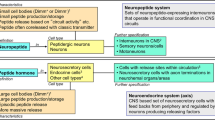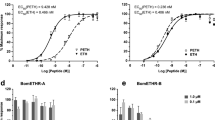Abstract
Insect neuropeptides are produced in less than 1% of the cells of the central nervous system. Despite this, they are important messenger molecules which influence nearly all physiological processes, including behaviour. They can act as transmitters, modulators and classical hormones, and often exhibit pleiotropic functions when released into the haemolymph. The large number of neuropeptides that has been identified from some of the model organisms among insects underlines the complexity of the neurosecretory system; studies about the coordinated actions of these substances are in their preliminary stages. Recent advances in insect neuropeptide research will be reviewed here, concentrating on the distribution of multiple peptide forms in the central nervous system and adjacent neurohaemal organs, and the role of neuropeptides in eclosion behaviour.
Similar content being viewed by others
Author information
Authors and Affiliations
Rights and permissions
About this article
Cite this article
Predel, R., Eckert, M. Neurosecretion: peptidergic systems in insects. Naturwissenschaften 87, 343–350 (2000). https://doi.org/10.1007/s001140050737
Issue Date:
DOI: https://doi.org/10.1007/s001140050737




